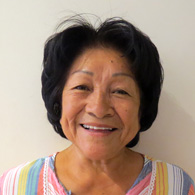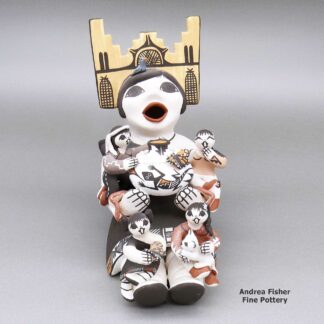Ray, Marilyn

Marilyn Lewis Ray was born to Edward and Kathryn Lewis of Acoma Pueblo in 1954. She is a member of one of the two non-related Lewis families at Acoma: the Lucy Lewis family of traditional potters is the more well known while the children of Kathryn Lewis (Rebecca Lucario, Marilyn Ray, Carolyn Concho, Diane Lewis and Judy Lewis) have been making some of the most innovative and contemporary pottery being produced at Acoma. Each member of the family has carved out their own particular niche and Marilyn has long been focused on the art of making storytellers.
In Native American pottery art, a storyteller refers to a figure, usually a grandparent, adorned with smaller figures of children. Pueblo society histories are oral, to be sung in their native languages. The storyteller is an elder figure who sings the stories of their tribal culture to pass that knowledge on to their children. Helen Cordero of Cochiti Pueblo made the first storyteller in 1964 in honor of her grandfather, a great Cochiti storyteller.
The tradition soon spread to other pueblos, each potter adapting the dress and hairstyles to their own society but also each exhibiting a distinctive and delightful expression of the intense love the Pueblo people have for their children. Figures with an open mouth represent a grandparent or parent singing or telling stories to their children.
Marilyn’s playful figures capture her deep sense of humor: some of the children are climbing, some playing with puppies, some just being mischievous. She says she was inspired to make pottery by her late grandmother, Delores S. Sanchez, who encouraged her to make small animal figurines when she was twelve. Marilyn also sold her small pieces alongside those of her grandmother.
Her grandparents took her with them to help mine the clay. They taught her to use natural materials that were abundant to decorate her pieces. Most importantly, they taught her how to use the sacred earth to make a living. Marilyn’s motivation intensified after her grandmother gave her a special polishing stone.
Years later, Marilyn grew bored with just black, orange and white, the basic colors for which Acoma potters are known. She began to experiment with colored clay slips and over the next four years discovered twelve new colors to use on her figures. She says she tries to work on figurines at least six hours a day but she also has to tend to her family: as she has told us many times, “I love to be home with my husband and Cinnamon Dog.”
In addition to her storytellers, Marilyn likes to make Friendship/Corn Meal bowls (with butterflies, lady bugs and children hanging over the sides), Nativities, Singing Maidens, Corn Maidens and animals (including bear storytellers with cubs and turtles carrying children). Her sense of humor and love of life are evident in all her creations. Marilyn also puts time aside to work with other potters, both to inspire and to be inspired.
Marilyn’s storytellers have become collectors items. They have been featured in several books and magazines including Douglas Congdon-Martin’s book Storytellers and other Figurative Pottery. In January 1993, her work was even featured on an Albuquerque billboard.
Marilyn’s art has earned her more than 300 prize ribbons, including many from The Heard Museum Show in Phoenix, the Santa Fe Indian Market, Eight Northern Pueblos Arts and Crafts Show and Gallup Inter-Tribal Ceremonials, among others. She signs her work: “Marilyn Ray, Acoma, NM” along with a date and a lizard hallmark.
Some Awards earned by Marilyn
- 2010 Santa Fe Indian Market, Classification II – Pottery, Division D – Contemporary pottery, any form or design, using Native materials with or without added decorative elements, all firing techniques, Category 705 – Figures, including sets: Second Place
- 2009 Santa Fe Indian Market, Classification II – Pottery, Division D – Contemporary pottery, any form or design, using Native materials with or without added decorative elements, all firing techniques, Category 705 – Figures, including sets: First Place
- 2008 Santa Fe Indian Market, Classification II – Pottery, Division H – Non-traditional pottery, any form or design, using traditional materials with added non-clay decorative elements, all firing techniques, Category 1505 – Figures (set of two or more separate pieces): First Place
- 2005 Santa Fe Indian Market: Special Awards, Standards Award II, Pottery: New Innovation in Clay (Limited to Plates)
- 2004 Santa Fe Indian Market, Classification II – Pottery, Division G – Non-traditional pottery, using traditional techniques and materials, any form or design, Category 1407 – Items with figures or designs in relief: Second Place
- 2004 Santa Fe Indian Market, Classification II – Pottery, Division H – Non-traditional pottery using traditional materials and techniques with non-traditional decorative elements, Category 1505 – Figures (set of two or more separate pieces): First Place
- 2004 Santa Fe Indian Market, Classification II – Pottery, Division H – Non-traditional pottery using traditional materials and techniques with non-traditional decorative elements, Category 1508 – Miscellaneous: Second Place
- 2003 Santa Fe Indian Market, Classification II – Pottery, Division F – Traditional pottery, painted designs on matte or semi-matte surface, Category 1306 – Storytellers, all one piece: First Place
- 2003 Santa Fe Indian Market, Classification II – Pottery, Division G – Non-traditional pottery, using traditional materials and techniques, any form or design, Category 1411 – Miscellaneous: Second Place
- 2002 Santa Fe Indian Market, Classification II – Pottery, Division H – Non-traditional pottery using traditional materials and techniques with non-traditional decorative elements, any form or design, Category 1506 – Figures (sets of two or more pieces): Third Place
- 2002 Santa Fe Indian Market, Classification II – Pottery, Division J – Non-traditional pottery, all materials all techniques with or without decorative elements, any form or design, Category 1607 – Sets & Scenes (multi-figures, includes nativity scenes and storyteller bowls): Second Place
- 2001 Santa Fe Indian Market, Classification II – Pottery, Division G – Non-traditional pottery, new forms and designs, using traditional materials and all firing techniques, Category 1405 – Figures, sets of two or more pieces: Second Place
- 2000 Santa Fe Indian Market, Classification II – Pottery, Division H – Non-traditional pottery, any forms using non-traditional materials or techniques, Category 1510 – Single figures (animal & other), all other: Second Place
- 2000 Santa Fe Indian Market, Classification II – Pottery, Division H – Non-traditional pottery, any forms using non-traditional materials or techniques, Category 1511 – Sets & scenes (nativity scenes): Second Place
- 1999 Santa Fe Indian Market, Classification II – Pottery, Division H – Non-traditional any forms using non-traditional materials or techniques, Category 1513 – Storyteller (non-traditional), up to 7″ in height: Second Place
- 1998 Santa Fe Indian Market, Classification II – Pottery, Division F – Traditional pottery, painted designs on matte or semi-matte surface, all forms except jars, Category 1310 – Storytellers (all one piece), other than Cochiti: Third Place
- 1998 Santa Fe Indian Market, Classification II – Pottery, Division G – Non-traditional pottery, new forms, using traditional materials and techniques, Category 1407 – Figures (all one piece), over 7″: Third Place
- 1997 Santa Fe Indian Market, Classification II – Pottery, Division F – Traditional pottery, painted designs on matte or semi-matte surface, all forms except jars, Category 1310 – Storytellers (all one piece): First Place
- 1997 Santa Fe Indian Market, Classification II – Pottery, Division F – Traditional pottery, painted designs on matte or semi-matte surface, all forms except jars, Category 1310 – Storytellers (all one piece): Third Place
- 1997 Santa Fe Indian Market, Classification II – Pottery, Division H – Non-traditional any forms using non-traditional materials or techniques, Category 1513 – Storyteller (non-traditional), up to 7″ in height: Second Place
- 1997 14th Annual Phoenix Indian Center Bola Dinner and Awards Banquet: Collector’s Choice Artist
- 1996 Santa Fe Indian Market, Classification II – Pottery, Division H – Non-traditional any forms using non-traditional materials or techniques, Category 1510 – Single figures (animal & others): Third Place
- 1996 Santa Fe Indian Market, Classification II – Pottery, Division H – Non-traditional any forms using non-traditional materials or techniques, Category 1513 – Storyteller (non-traditional) up to 7″ in height: First Place
- 1996 Santa Fe Indian Market, Classification II – Pottery, Division J – Traditional forms, jars, melon bowls, seed bowls, black, Category 1609 – Non-traditional forms: First Place
- 1994 Santa Fe Indian Market, Classification II – Pottery, Division G – Traditional pottery, painted designs on matte or semi-matte surface, all forms except jars, Category 1410 – Storytellers (all one place): First Place
- 1994 Santa Fe Indian Market, Classification II – Pottery, Division G – Traditional pottery, painted designs on matte or semi-matte surface, all forms except jars, Category 1411 – Nativity scenes: Third Place
- 1994 Santa Fe Indian Market, Classification II – Pottery, Division H – Non-traditional, new forms, using traditional materials & techniques, Category 1506 – Figures (all one piece): First Place
- 1994 Santa Fe Indian Market, Classification II – Pottery, Division H – Non-traditional, new forms, using traditional materials & techniques, Category 1507 – Figures (sets of two or more pieces): Third Place
- 1994 Santa Fe Indian Market, Classification II – Pottery, Division H – Non-traditional, new forms, using traditional materials & techniques, Category 1509 – Miscellaneous, over 7″: Second Place
- 1989 Santa Fe Indian Market, Classification II – Pottery, Division K – Pottery Miniatures, 3″ or less in height or diameter, Category 1509 – Figures, sets of two or more figures: Third Place
- 1983 Santa Fe Indian Market, Classification II – Pottery, Division F – Traditional, painted designs on matte or semi-matte surface: Third Place
Showing all 2 results
-

Marilyn Ray, zzac3b509, Storyteller figure with four children
$1,250.00 Add to cart -

Marilyn Ray, zzac3b510, Storyteller figure with five children
$1,750.00 Add to cart
Showing all 2 results